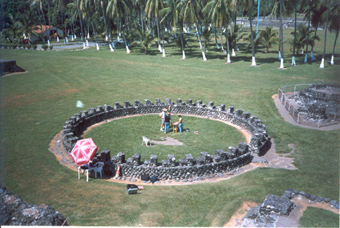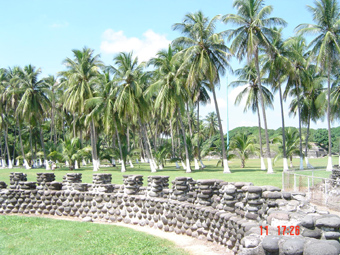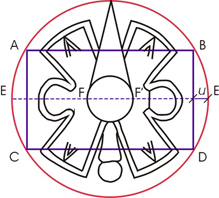[ Lay Language Paper
Index | Press Room ]
Acoustical Phenomenon in
Ancient Totonac's Monument
Jos Snchez-Dehesa-
jsdehesa@upvnet.upv.es
Andreas Hkansson, Francisco Cervera
Nanophotonics Technology Center
Univ. Polytechnic of Valencia
E-46022 Valencia, Spain
F. Meseguer
(Unidad Asociada CSIC-UPV, Valencia, Spain)
B. Manzanares-Martnez, F. Ramos-Mendieta
(CIFUS, Univ. of Sonora, Hermosillo, Mexico)
Popular version
of paper 5aAA8
Presented Friday morning, May 28, 2004
147th ASA Meeting,
New York, NY
The Maya is the
most notable of the classical civilizations in
Mesoamerica. Calendrical documents have demonstrated that mathematics and
astronomy are among the intellectual hallmarks of the Maya. They also made
fundamental achievements in monumental architecture; the Maya built magnificent
ceremonial buildings, such as pyramidal temples as well as palaces and
observatories. Recent research has uncovered equally remarkable acoustic
properties associated with Mayan architecture. For example, there are ball
courts that are characterized by the fact that a whisper at one end can be
heard clearly at the other more than 500 feet
away. Another example is the Kukulkan temple at Chichen Itza in Yucatan
(Mxico): a handclap made in front of one of the stairs stimulates two chirped
echoes that are similar to the Quetzal bird chirps. The connection between the
pyramid of Kukulkan and the Queztal bird is supported by a Mayan glyph from the
Dresden Codex.
The Totonac were contemporary with
the Maya and shared a similar culture. The Totonac also configured their
architecture in such a way that time and space were integrated. They also
constructed magnificent buildings. The most known are located at El Tajin
in the state of Veracruz (Mxico). Here, we report studies made at the
ceremonial site of Cempoala, located near the city Veracruz. The architecture in
this site is characterized by the crenellations of the buildings. A sonic
effect similar to the one reported in the pyramid at Chichen Itza also was
recorded by us in front of the pyramid called The Chimneys. Here, we report our
acoustical study of the larger round structure (see Figs. 1-2). According to the
booklet provided to the visitors this structure is "associated with gladiator
worship of Mexica (Aztec) origin, although it may have served as an intake for
rainwater." This monument was made by walls of rolling stones and clay with
stuccowork. The stucco has completely disappeared (see Fig. 2). Nevertheless, a
singular sonic effect is detectable by one's own ears in spite of the poor state
of conservation of the walls.
 |
 |
|
Figure 1. The
so called "gladiator circle" |
Figure 2. A
closer view of the circle |
The Acoustical
Phenomenon
Mr.
Bernardo Mendoza, a volunteer guide at the site, claims to be the first person
who observed the sonic effect reported here. He made us the following
demonstration. First, he
 |
| Fig.
3 Mr. Mendoza doing the
demonstration |
placed us at one selected point inside the
circle. This point was placed along the diameter that coincides with the East-West direction and separated about two meters from the
center. Then, he
went to the border of the circle and walked towards us, speaking at the same
time. When he arrived at about the same distance from the center in front of us,
we suddenly noticed reinforcement of Mr. Mendoza's voice that seemed to come
from all directions. This effect puzzled us so much that we came back after few
months to characterize it. Our basic equipment was a loudspeaker, several
microphones and a laptop for sound generation, data recording and analyzing. The
experimental set-up is described schematically in Figure
4. In brief, the sound
emitter (E), which is placed at one predetermined position on the East-West
direction, emits a 5 ms pulse consisting in a 440 Hz sinusoidal signal. A microphone receiver (R) connected to the laptop records both
the direct and the reflected/diffracted sound by the round wall. Figure 5
represents the data recorded at R for several positions along the E-W
direction. The time origin is chosen when the signal is emitted at E.
Different sound signals can be distinguished on the plots shown in Fig.
5: 1) ballistic (highlighted in yellow), it is the first arriving at
R; 2) 1st echo (highlighted in green), which arrives at
R after one reflection by the round wall; and 3) 2nd echo (highlighted in blue), which corresponds to the sound that arriving after two
reflections at the wall. The time signals in Figure 5 show that when the
microphone is at around 1.65 m (position F in Figure 4) the first
echo becomes comparable in magnitude to the ballistic sound. This fact
characterizes the phenomenon that is noticed by one's own ears. A series of
experiments were performed to confirm the phenomenon and they demonstrated that
the phenomenon is very robust; it holds even at heights as larger as 3 meters
above the ground. Therefore, it can be concluded that the circle acoustically
behaves as an ellipse since two singular points inside the circle, E and
F, behave as the foci of an elliptical cavity. It is clear that this
anomalous phenomenon comes out from the sound scattering by the round
crenellated wall. A theoretical treatment of the exact problem is a
cumbersome task. Nevertheless, an empirical model can be worked out in
order to obtain a physical insight of this phenomenon. Thus, on an existing flat
crenellated wall we established as a function of the angle impinging the wall
the points at which the sound could be considered as effectively reflected by a
rigid wall. We concluded that the circle can be replaced by a rigid wall whose
shape can be approximated by the low eccentric ellipse that is represented by a
red line in Figure 4; it looks like a "flattened circle." The foci of this ellipse
are in agreement with the positions at which the acoustical phenomenon was
measured.
 |
 |
|
Figure 4. Scheme
of the circle and possible paths for sound propagation inside the
circle |
Figure
5. Pulse propagation measurements |
The Circle of Venus
Contrary to the information
provided to the visitors, we speculate that this monument could be devoted to
the god of wind (Ehcatl). Effectively, round structures found in
Mesoamerica were devoted to this god since it was told that "the god of wind
hates the angles that break the flux of air." Also, we believe that this
monument and the full ceremonial site was probably dedicated to
Quetzacatl, the "sovereign plumed serpent," the main deity of the
pre-Colombian religion in Mesoamerica. In this light, the crenellated walls
would represent the undulations of the "sacred serpent". Moreover, we propose
that the Totonac encoded in this round structure their knowledge about the
movement of Venus. For example, we have found that when the more important
|

|
|
Figure 6. The
Calendrical stone Nahoui
Ollin inscribed in the circle of
Venus |
Calendrical stone Nahui Ollin of Malinalco is
inscribed into the circle (see Figure 6), a series of coincidences accurs, the
more remarkable being that the internal circle of the Nahui Ollin, which
might represent the orbit of earth, coincides with the circle passing
trough the acoustical foci. Since the center of the Nahui Ollin is
believed to define the position of the sun, the external circle could be
referred to the orbit of Venus. The most remarkable fact is that, acoustically,
the orbit of Venus appeared as a "flattened circle." But, when one studies the
flattened circles of the Mesoamerican art, one always observes that the ratio
between the larger diameter to the shorter gives a number between 1.05 and 1.07.
The "flattened circle" acoustically determined in this round structure gives
1.05. The question is, was all this accidental or by design? We hope that this
work stimulates further studies about the possible link between acoustics,
architecture and astronomy in the classical Mesoamerican cultures.
Acknowledgements. Work financially supported by Universidad Autnoma of Madrid and Banco
Santander-Central-Hispano
of Spain. We also thank to CONALCULTA-INAH-MEX that provided us with technical
support and permissions.








